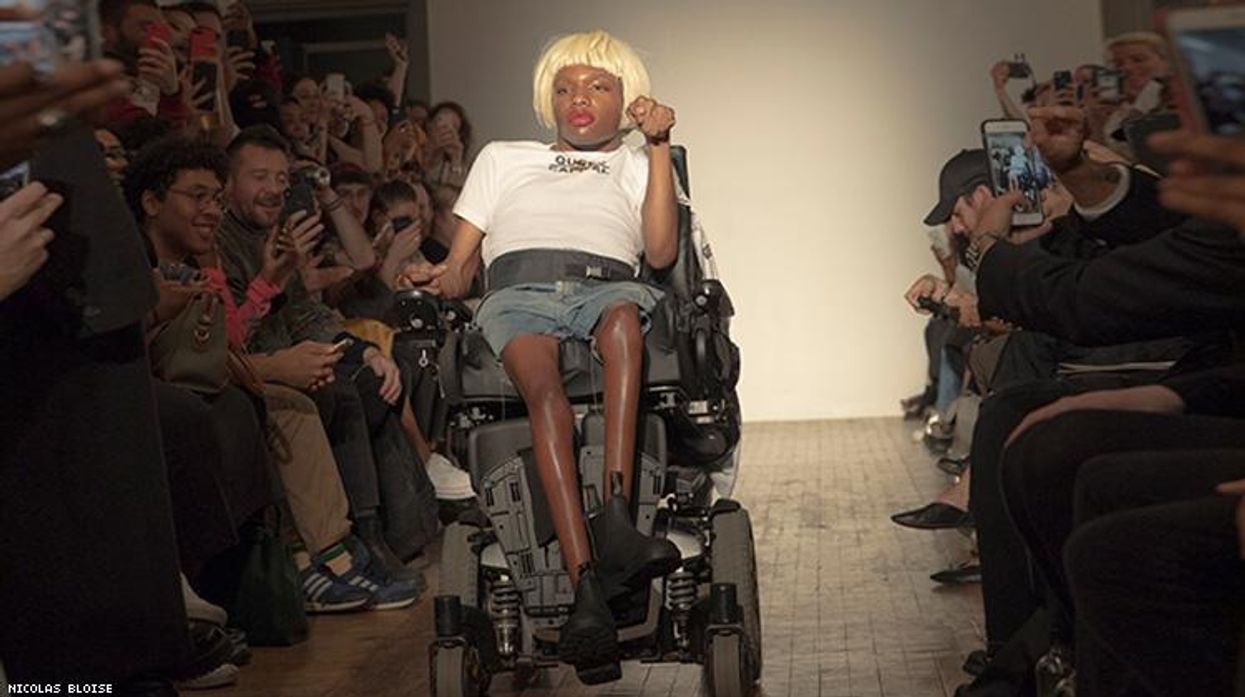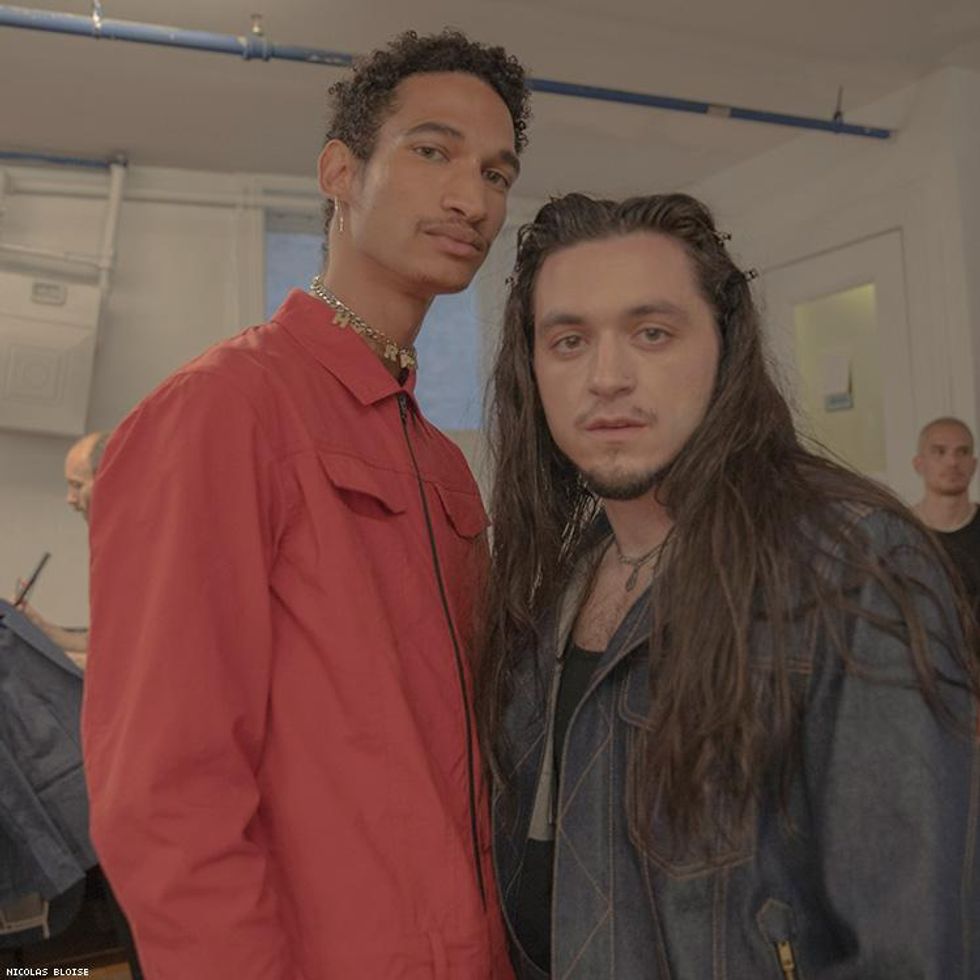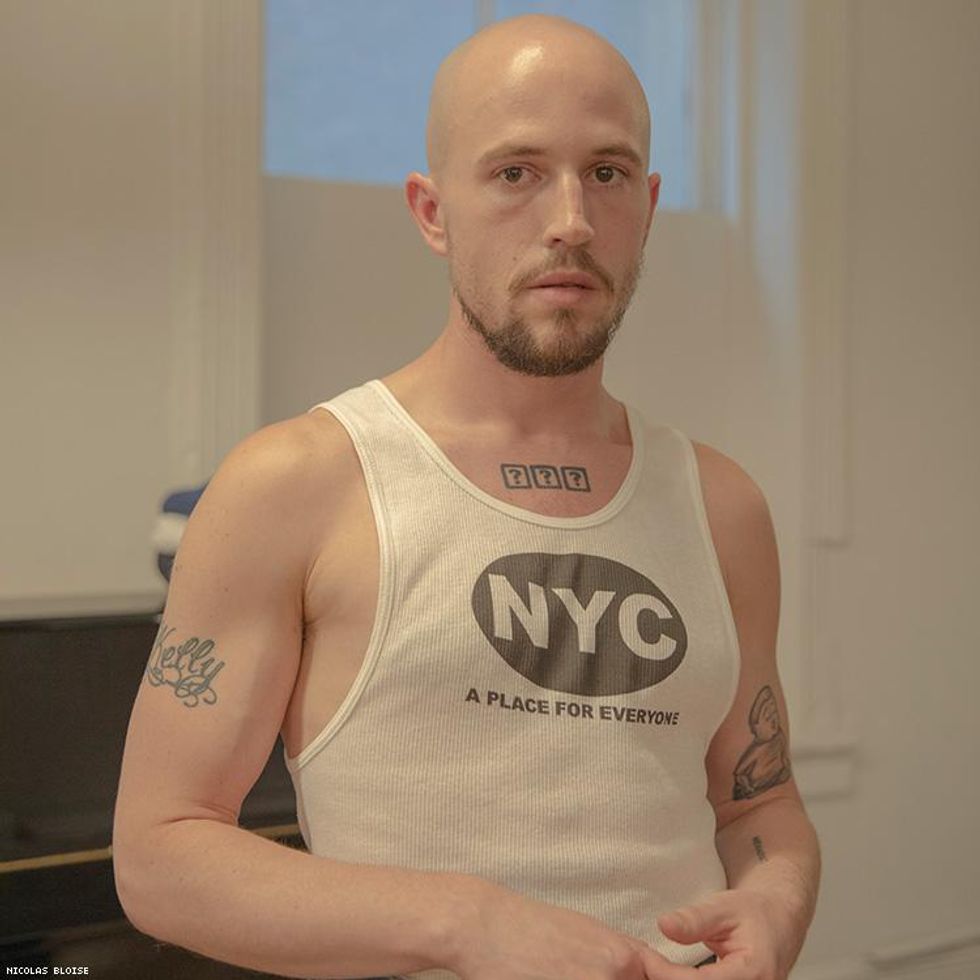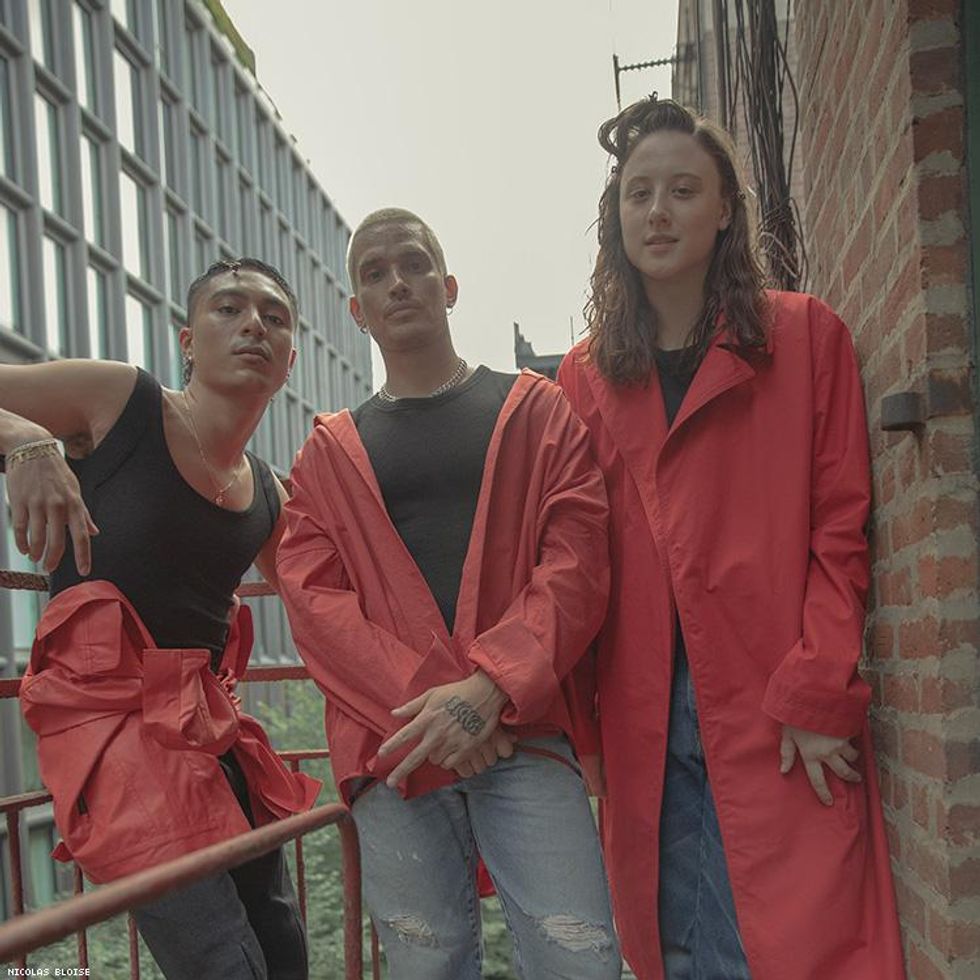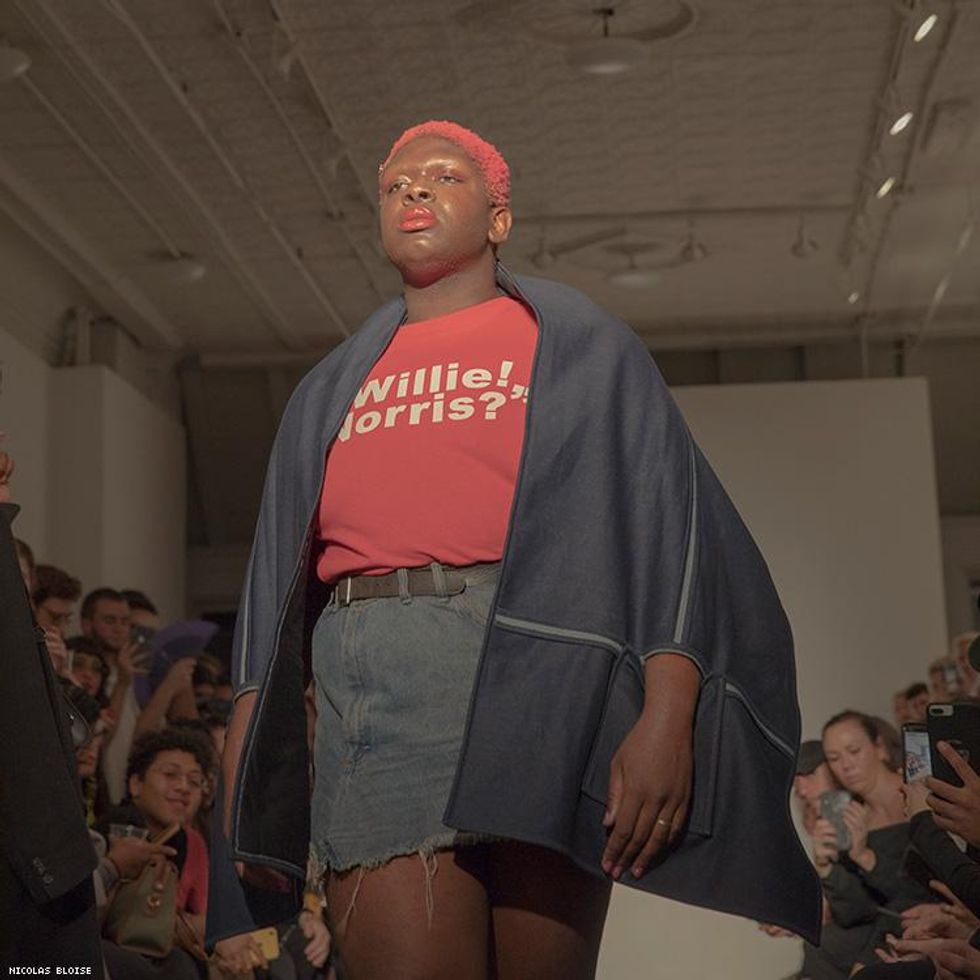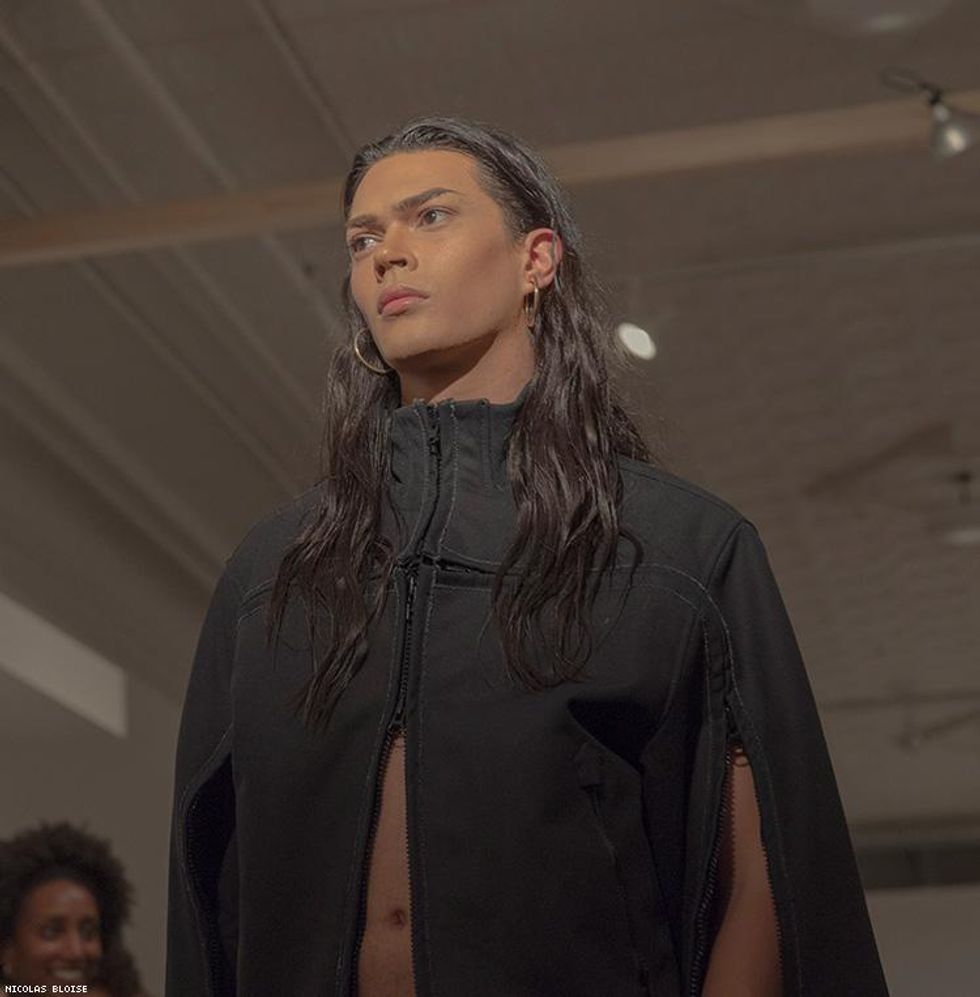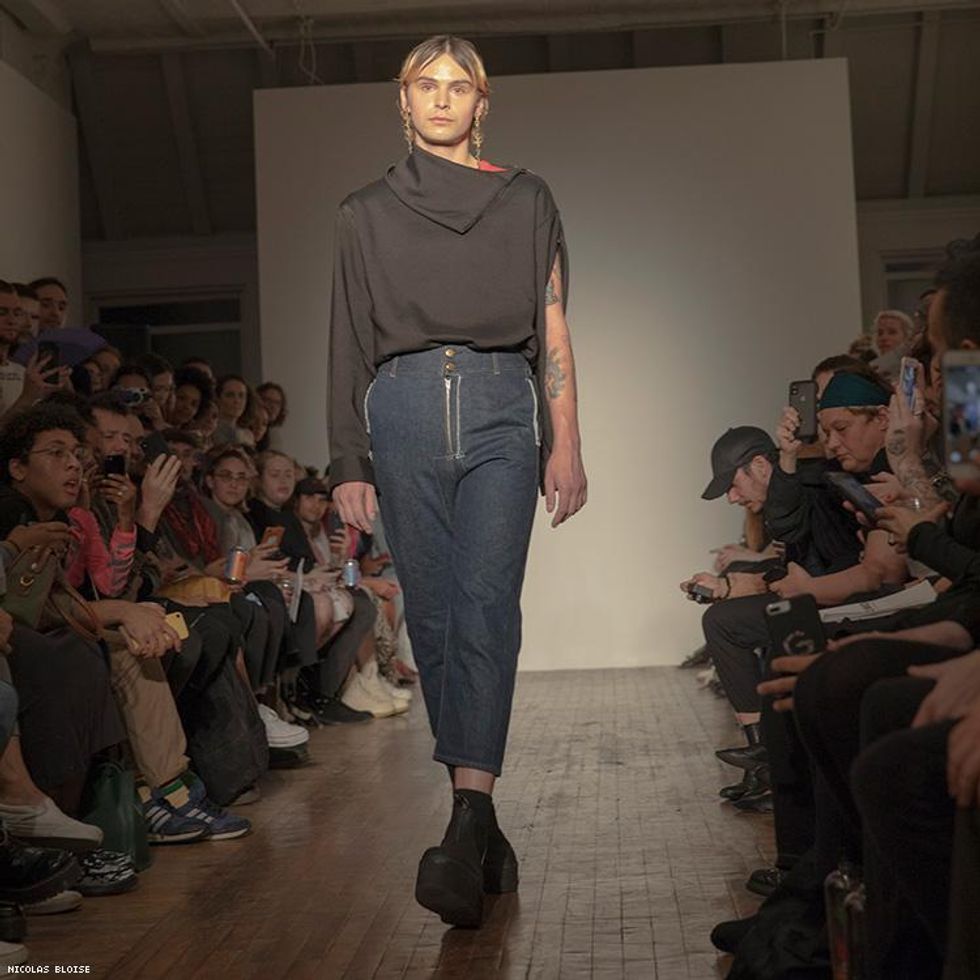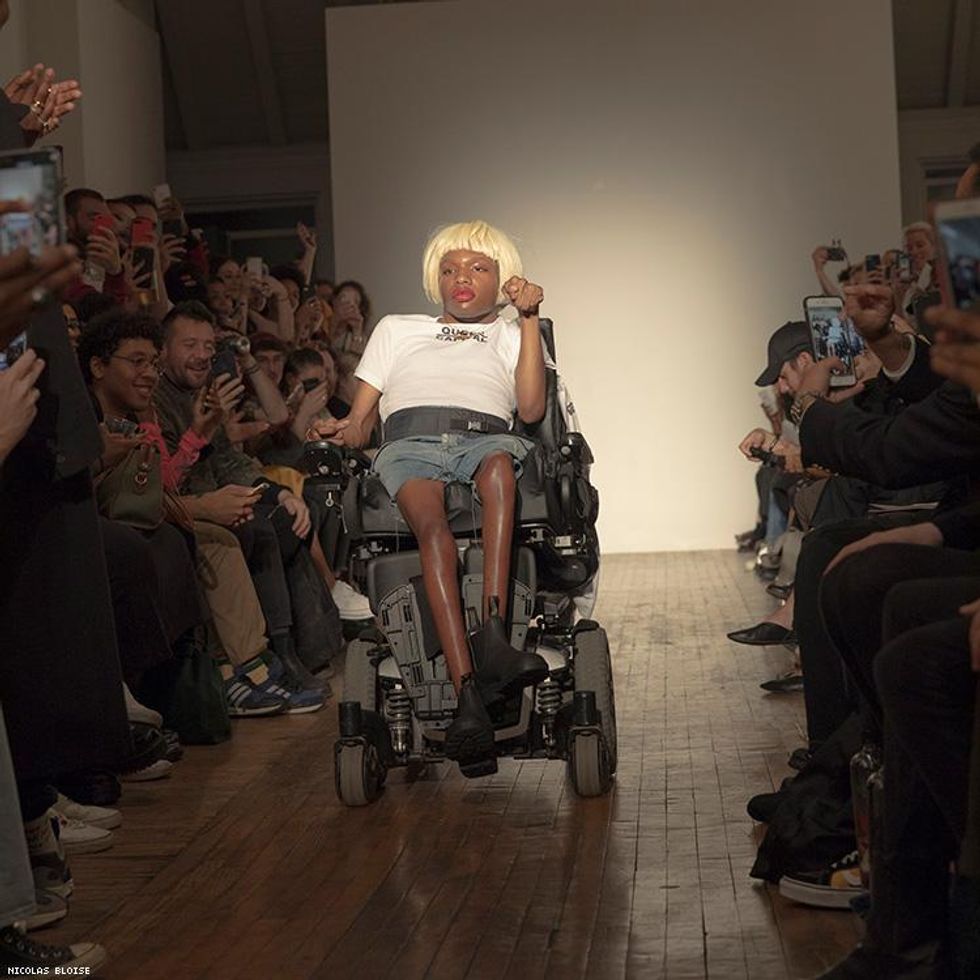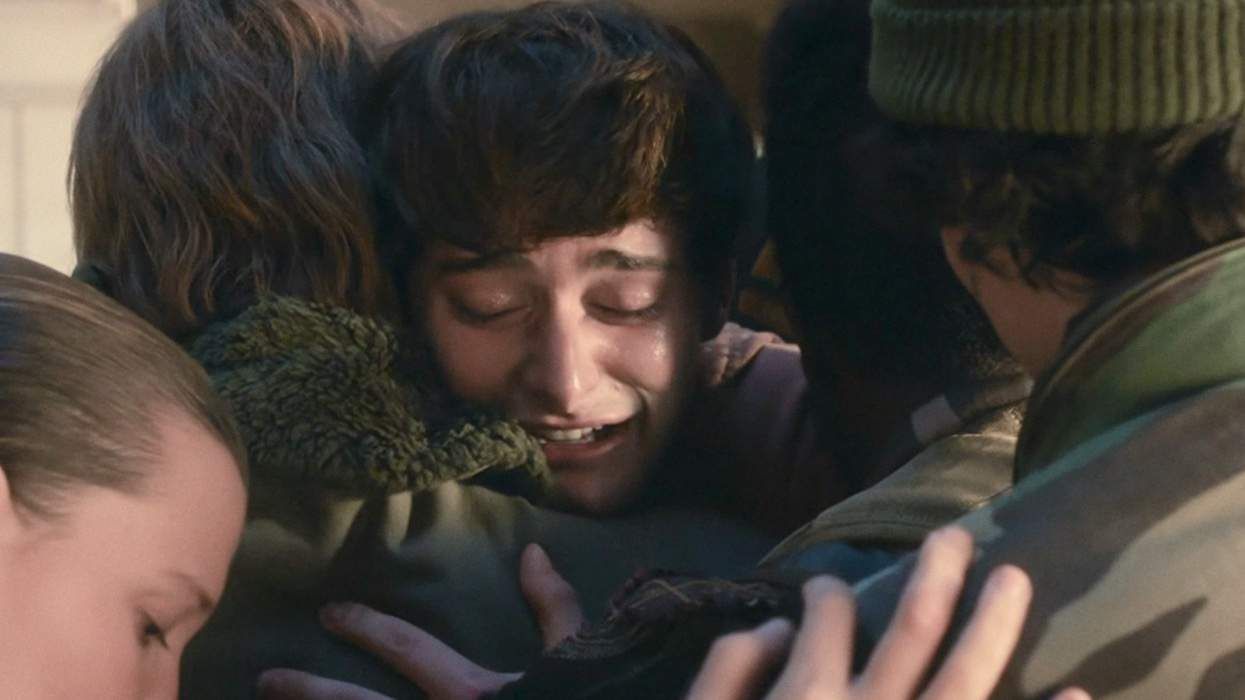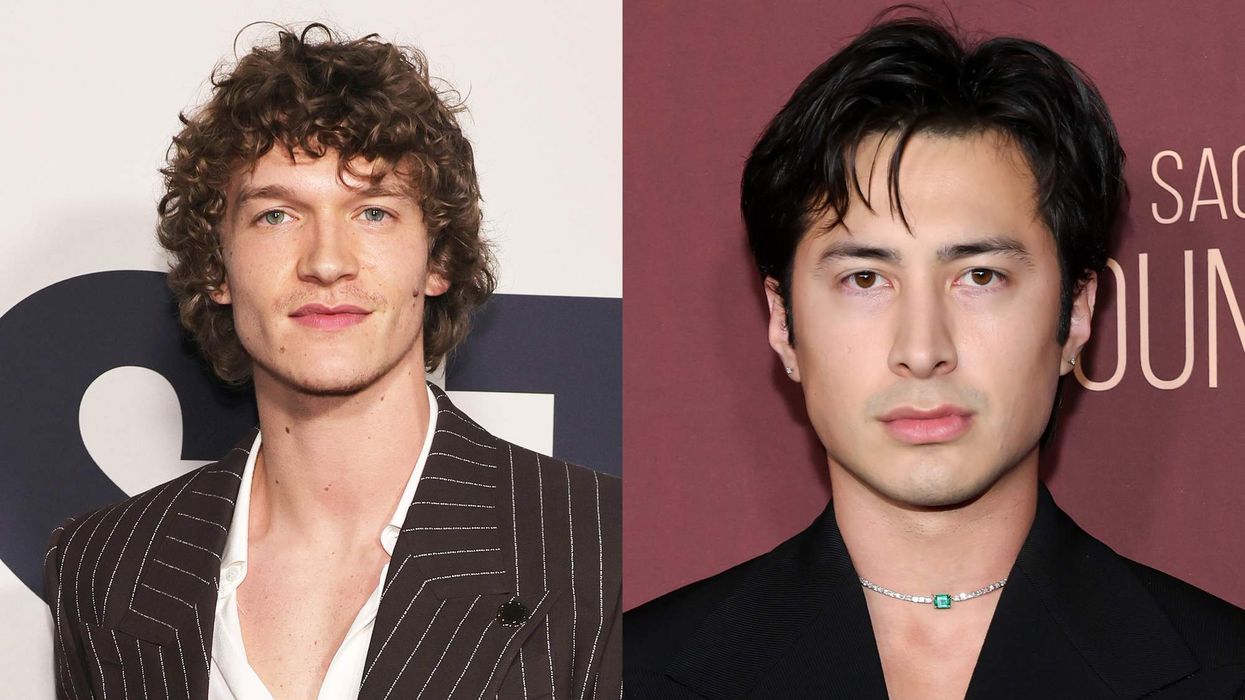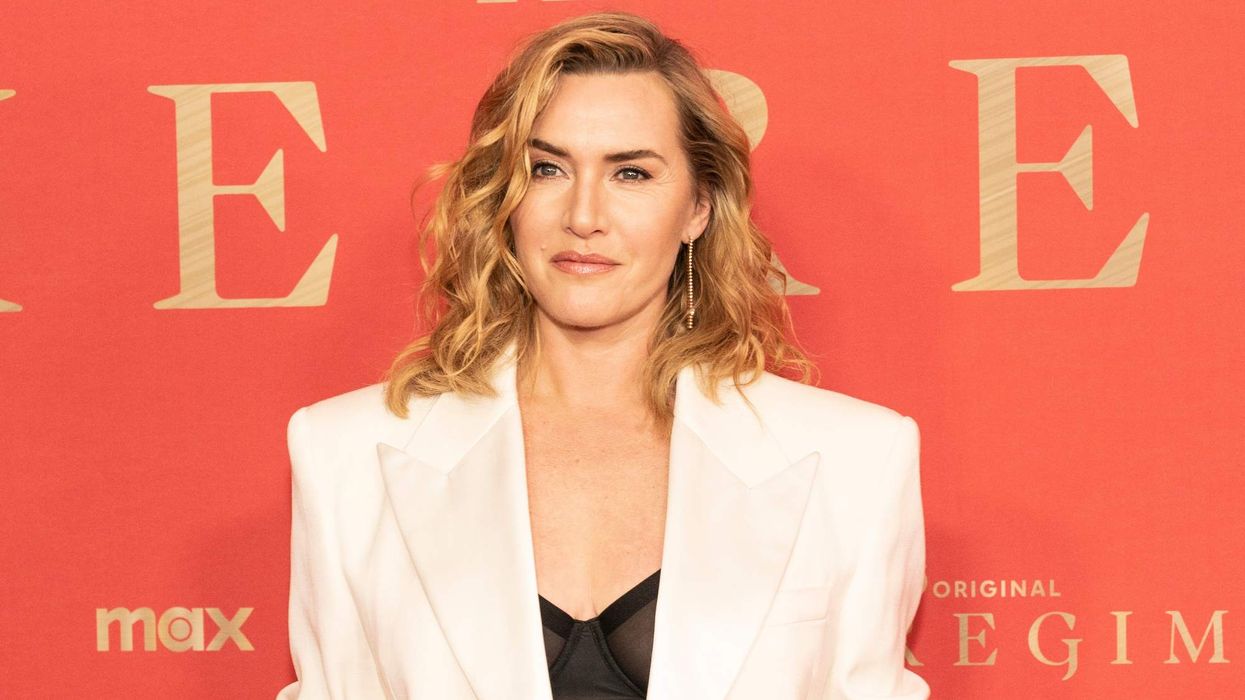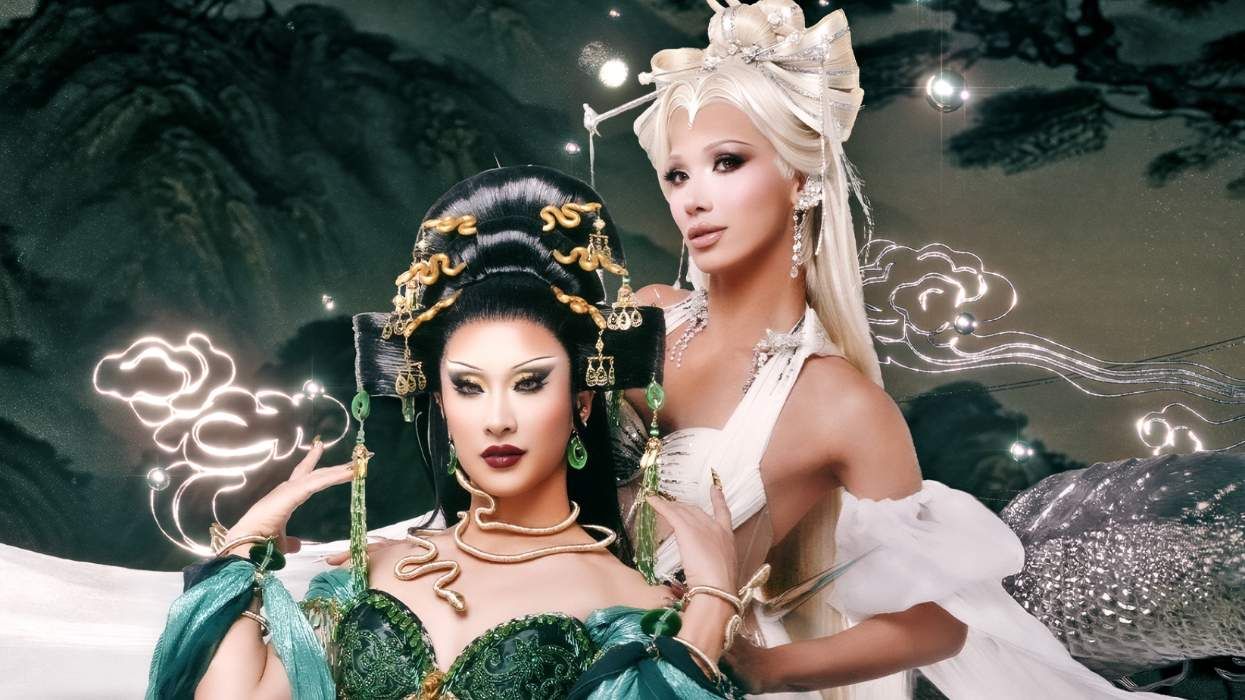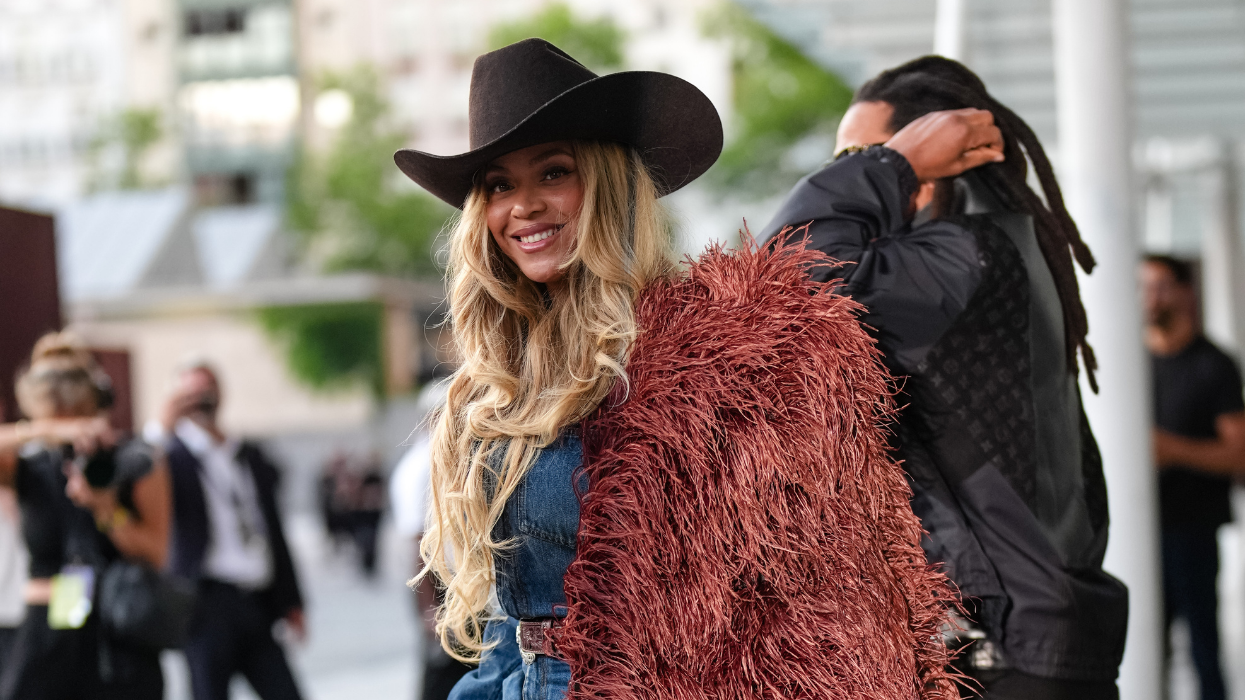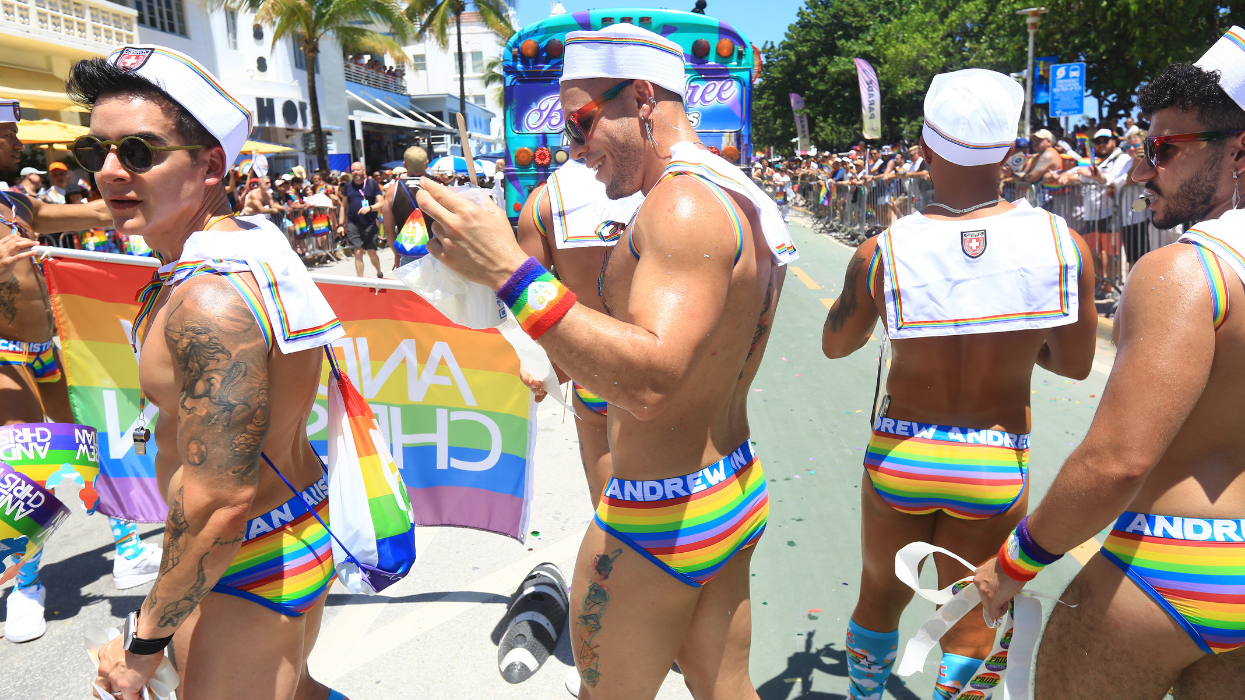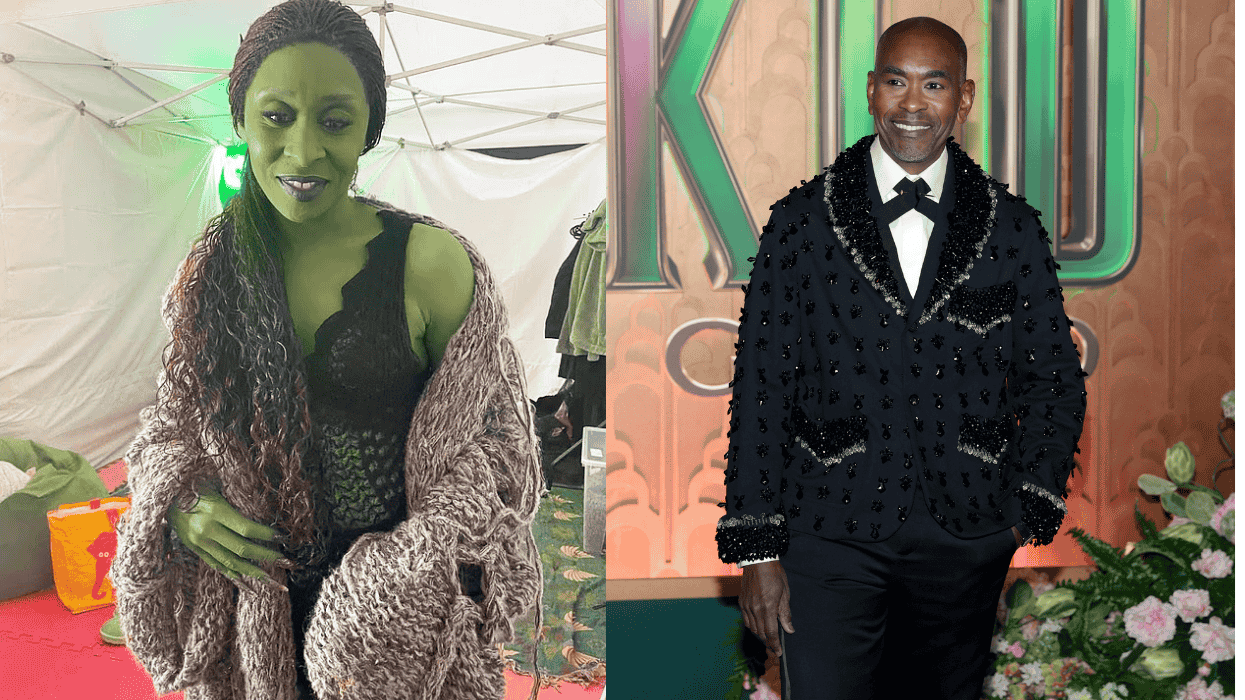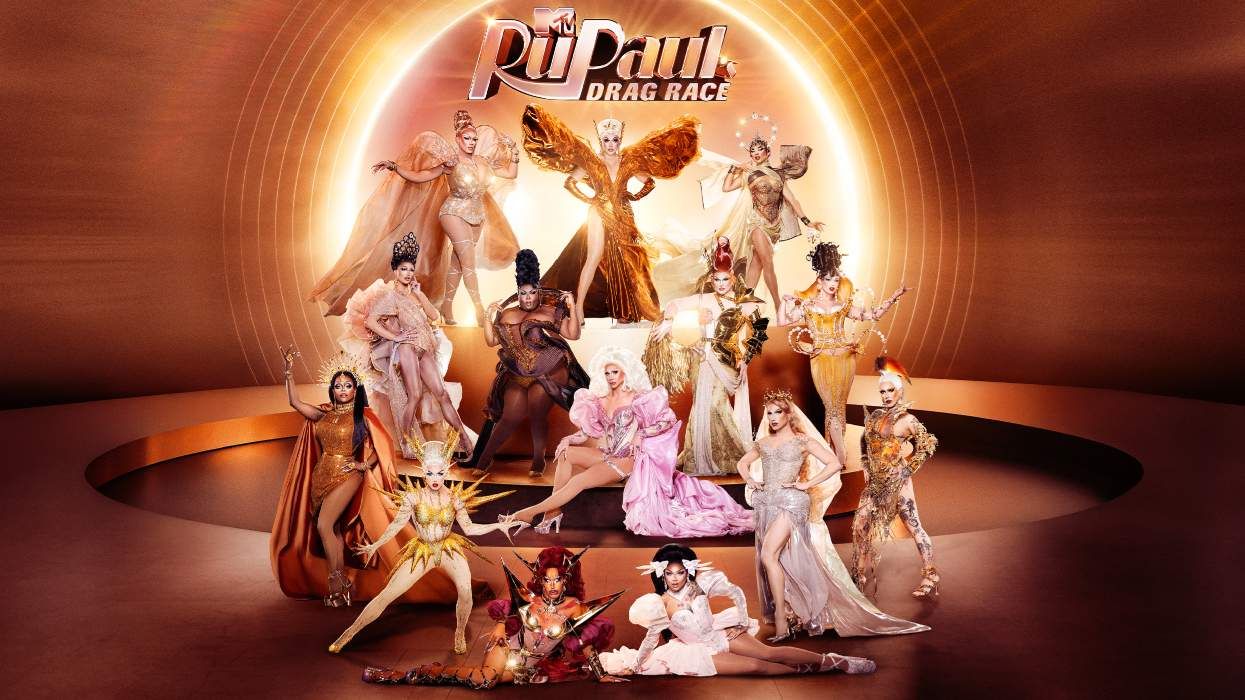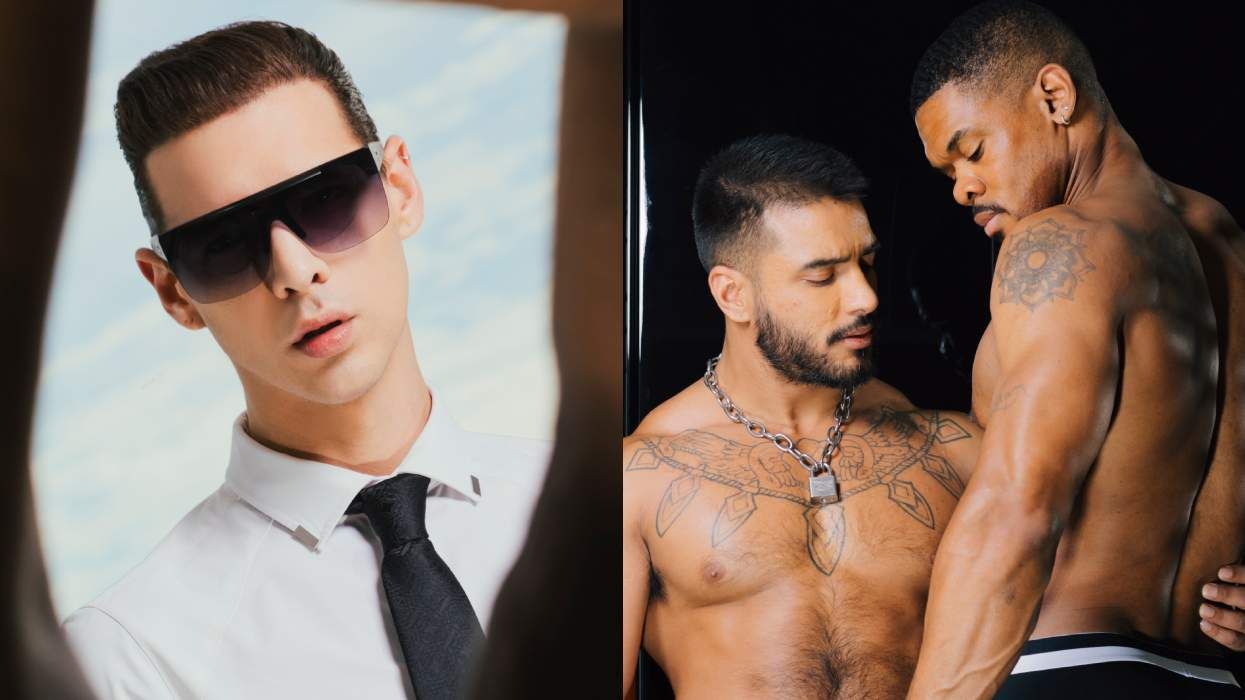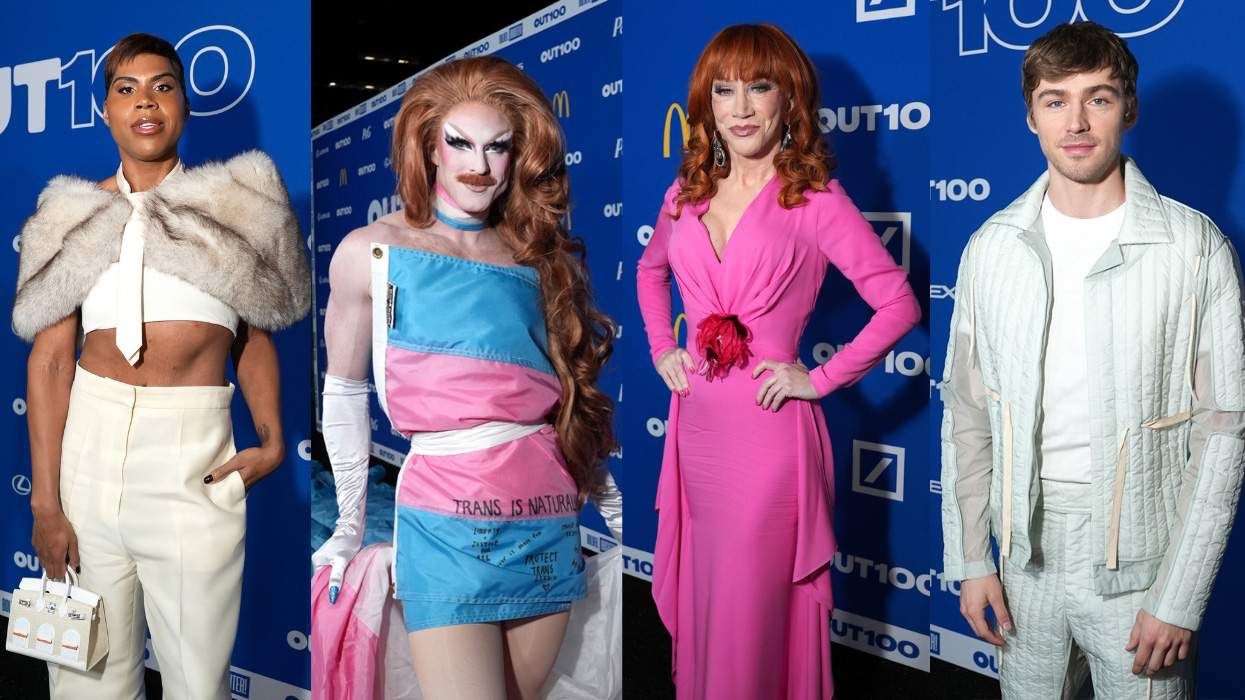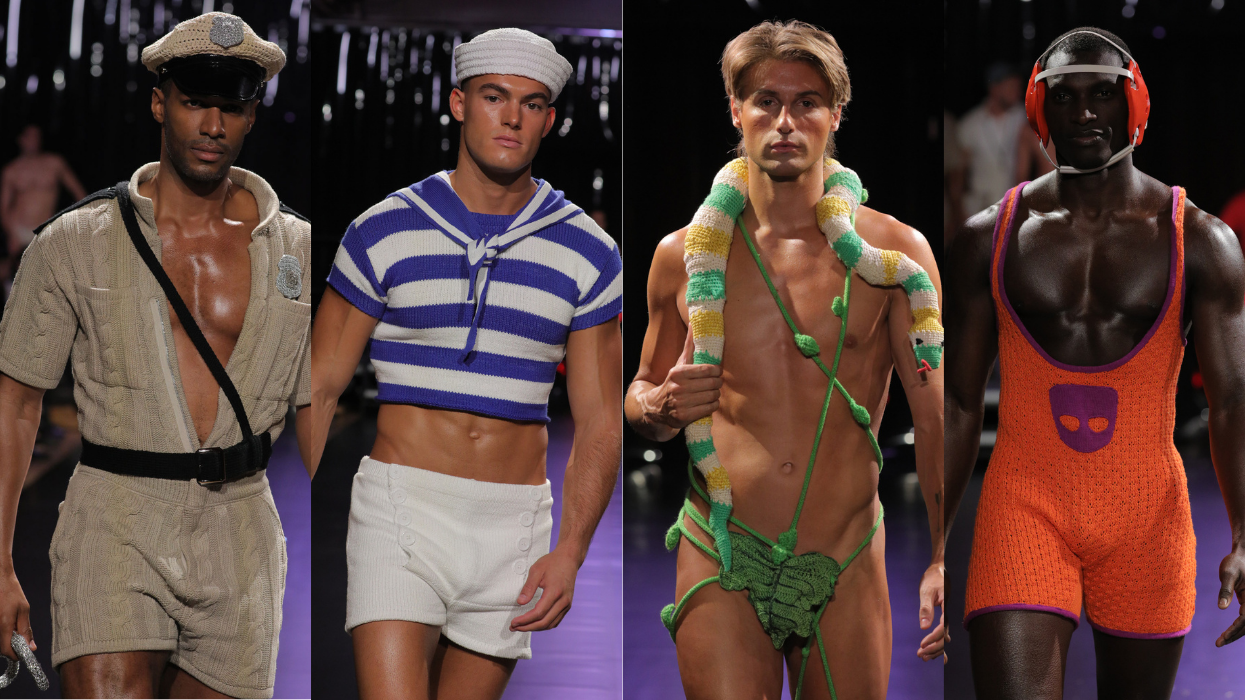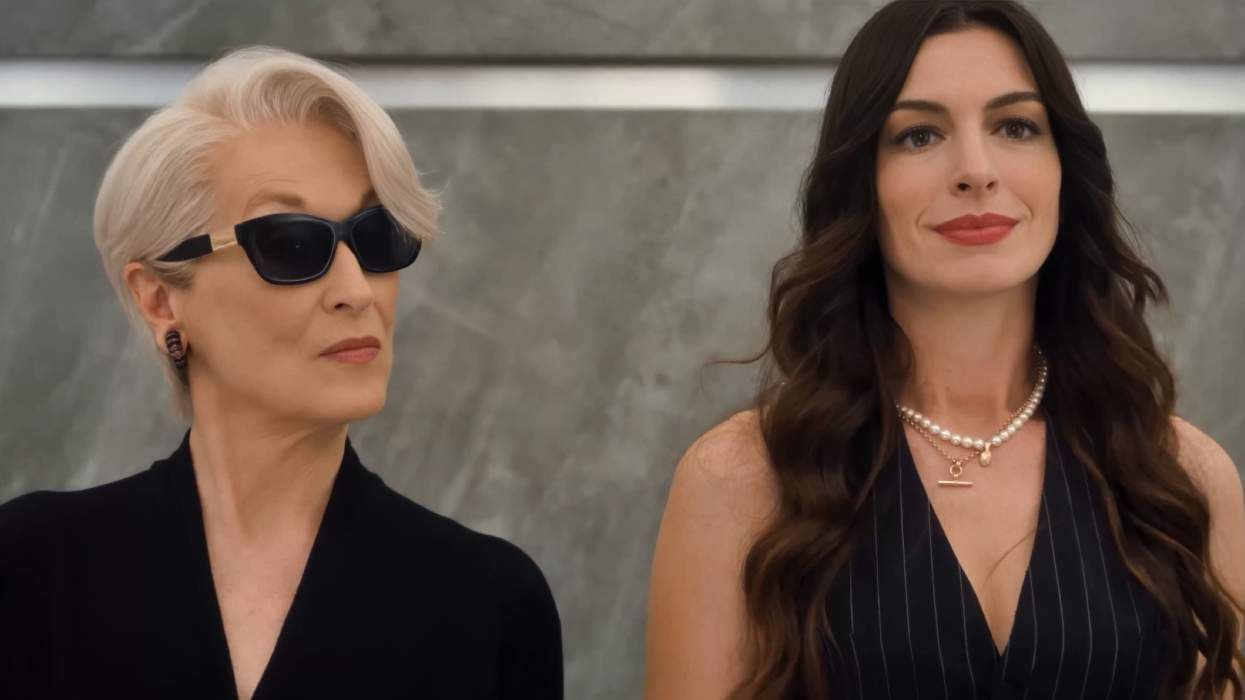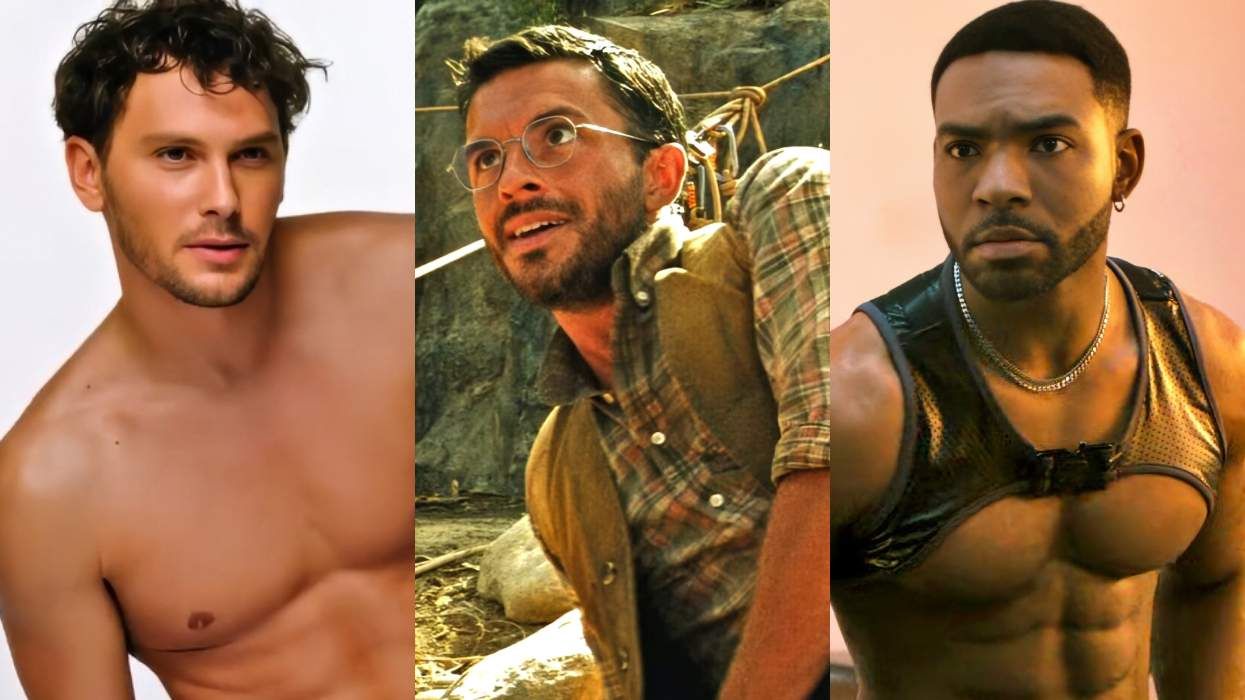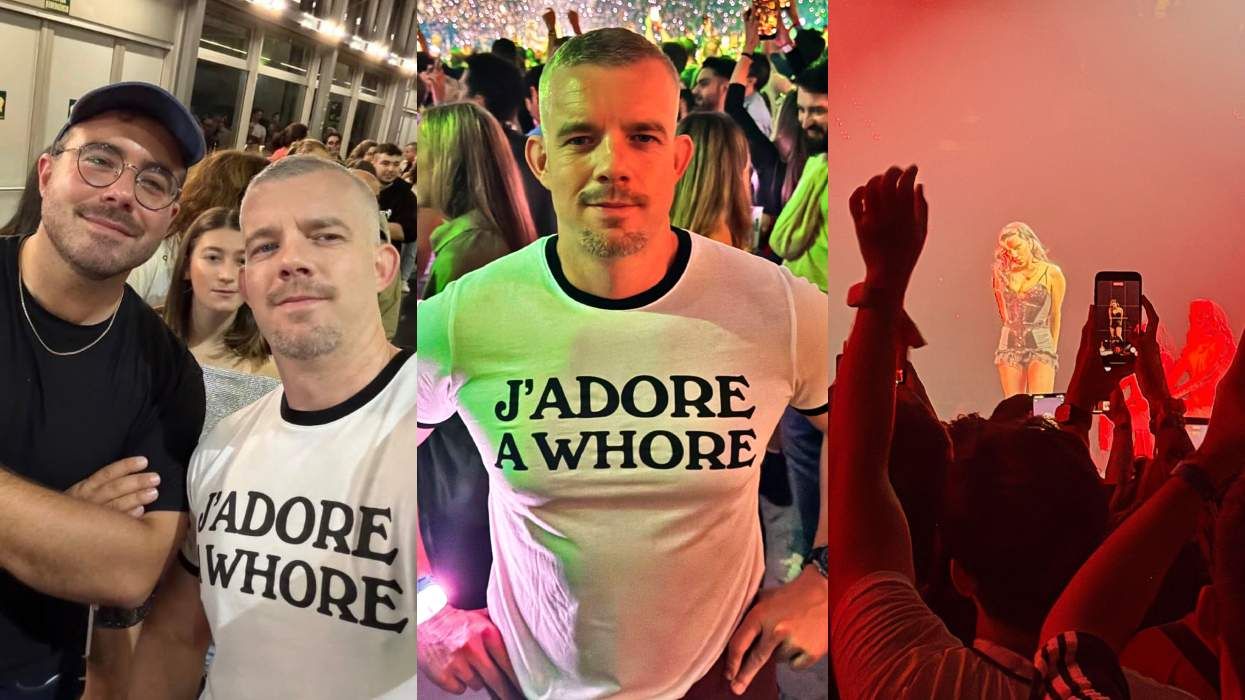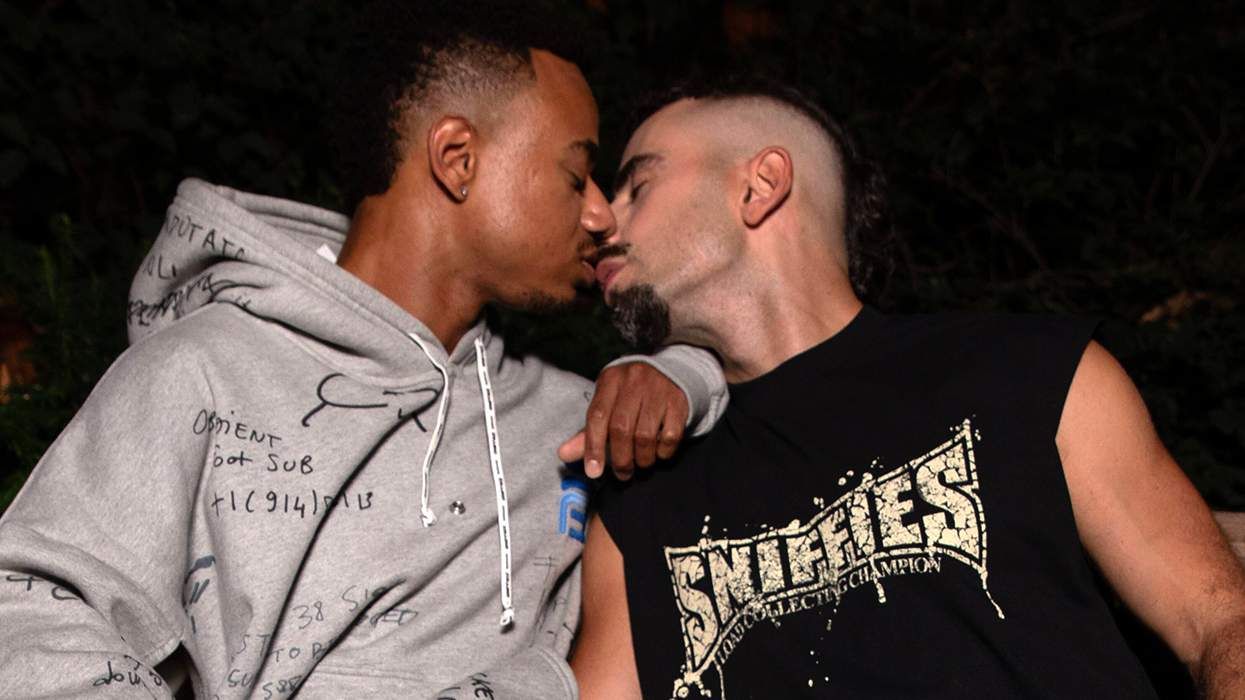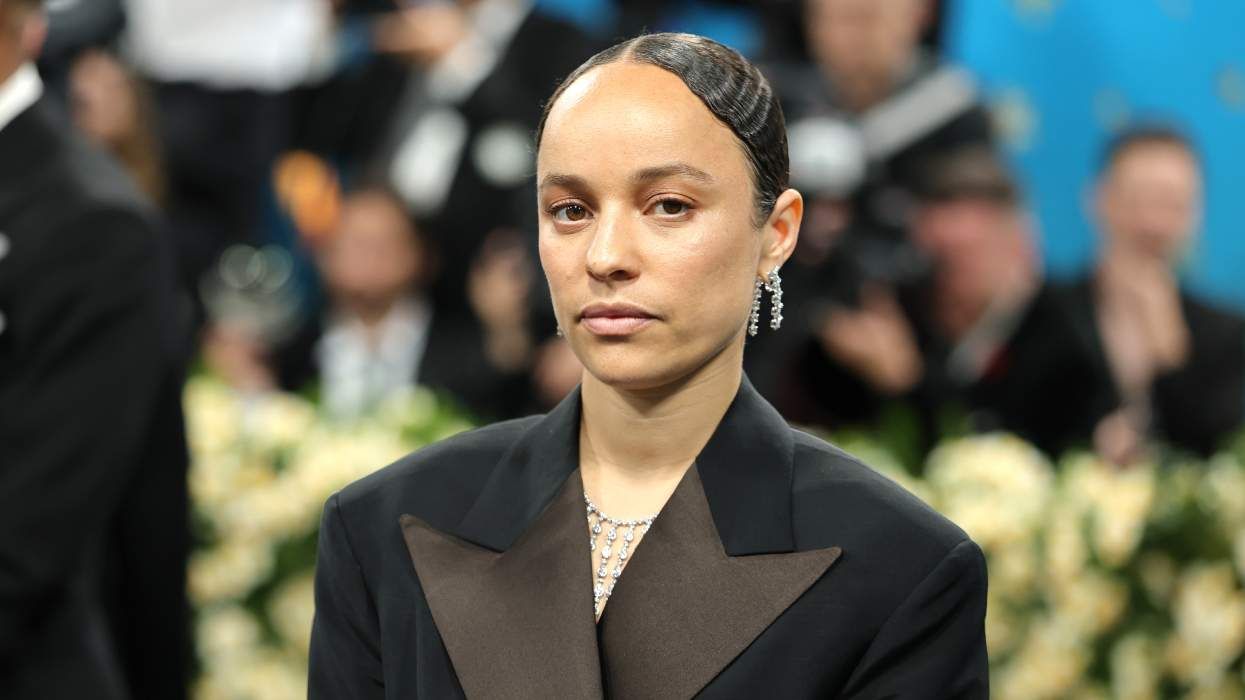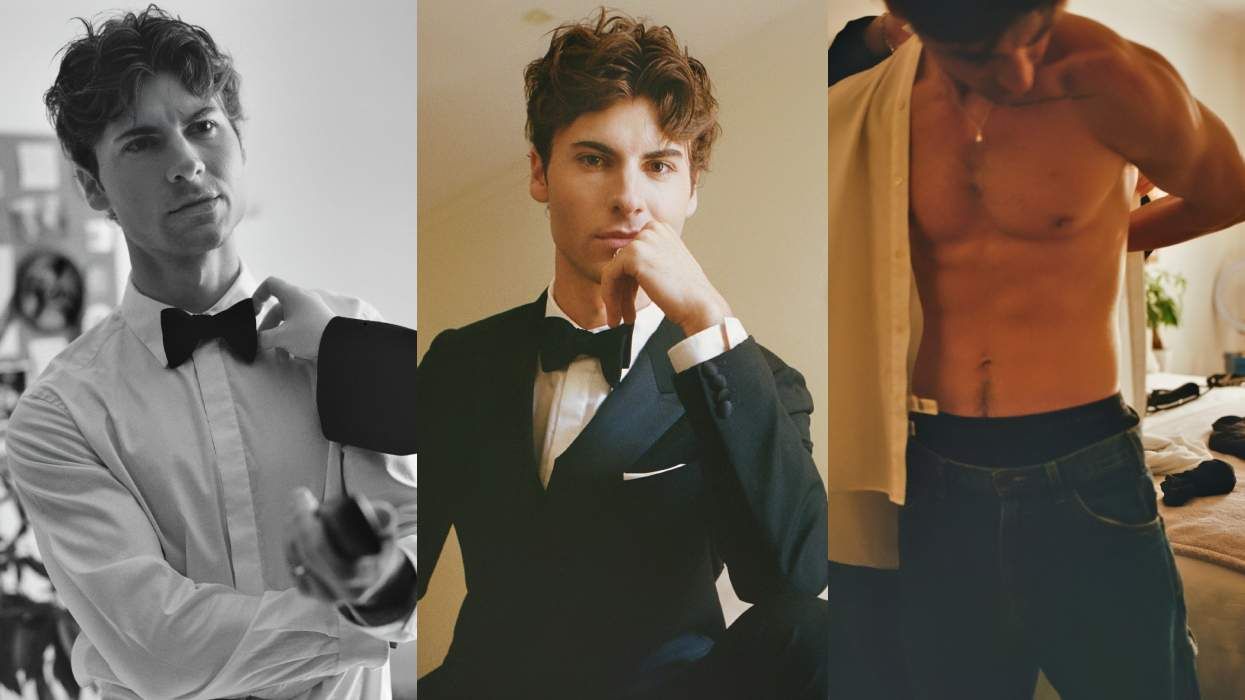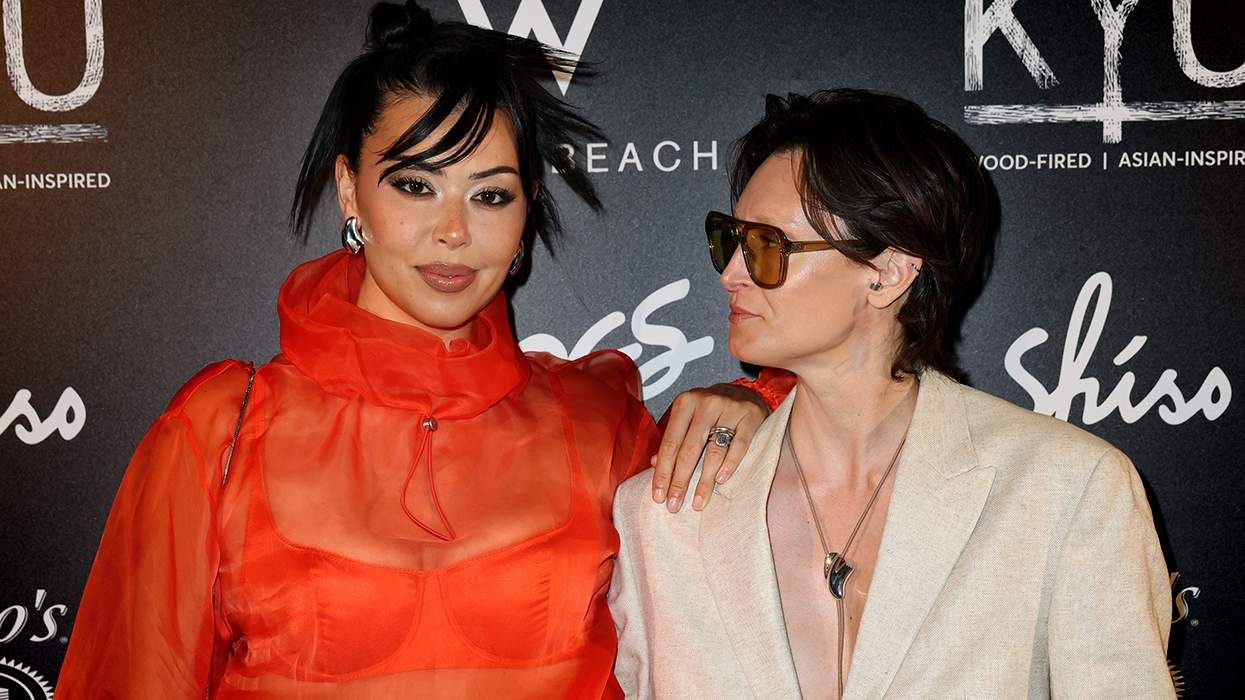The air is heavy and hot inside La Mama's East Village gallery, La Galleria, with dozens of New Yorkers pressed tightly against the walls on either side of a makeshift catwalk. It's the evening of June 13, and the crowd eagerly awaits the debut of Willie Norris's first fully fledged collection, anticipation for which has built to a crescendo after a successful Kickstarter campaign funding the emerging designer's inaugural runway presentation maxed out in a matter of days.
"This is my proposal for a wardrobe of economy with punches to the gut of glamour," the show notes read. With repurposed vintage shirts boasting propagandic slogans like "Promote Homosexuality" and "Queer / Capital," Norris's line of screenprinted tees has become the colored handkerchief of Brooklyn's stylish set (Out's own editor in chief has been spotted wearing Norris's tees courtside at Paris couture shows). But with this collection, dubbed PROMO, Norris drafts an ambitious blueprint for his label to come: a composite of elevated but wearable staples produced locally using deadstock fabric and designed with LGBTQ+ consumers in mind.
As the first model takes to the runway in a pair of torn light-wash jeans, a white paneled tank top, and a belted leather pouch styled cross-body, shouts from the crowd erupt to overpower the DJ booth's thumping playlist. Tapping nightlife mainstays like performers Charlene Incarnate and West Dakota, with model Aaron Philip closing the show in her first catwalk turn, the 19 looks are a flurry of fitted tees, leather accessories, and denim -- as jumpsuits, blazers, trousers, skirts -- featuring Norris's signature messaging emblazoned throughout. One model carries a heeled boot in lieu of a handbag, a baseball bat peeking from its mouth. Together, it reads like the uniform of some gay mafia: less rainbows and more smashed windows.
I walk eleventh, wearing cropped jeans and an adjustable funnel-necked pullover layered over a vermillion tank top. A few days prior, I meet Norris at his small Brooklyn workshop for a fitting. In the studio, he's excited to show me a pair of custom earrings he's made in collaboration with the artist Guelmo Rosa. Brushing away a pile of fabric scraps and beading, he pulls a pair of brass droplets from a black box that, when viewed together, spell out the words "utterly conceited." It's a phrase Norris has used before, printed on his mesh turtlenecks, but it also alludes to his mission: To celebrate, honor, and indulge queer identity is to priotize the capital of LGBTQ+ people, rather than the forces that seek to capitalize on them. We chat as I get dressed.
How did you come to fashion?
I've been making clothes my whole life because I was really involved in theater when I was growing up. I was always doing the costumes. I moved to New York when I was 17 to go to Parsons [School of Design] and, in my third semester there, I took a course taught by the designer Susan Cianciolo. I began focusing all of my attention on this one class and, because I already had the technical skills, Susan started to give me freelance work.
I worked with her on and off in every capacity. I did everything -- show planning, sewing, production. In a way, she was my college. I began looking at how much I was spending to go to school, and I realized I was actually making money from Susan. So I made the 19-year-old decision to just stop going. I didn't even drop out -- I just stopped going.
Since then, you've worked for the designers Isaac Mizrahi and Maria Cornejo.
From there, I met the creative director of Isaac Mizrahi, who just so happened to have been Susan's first assistant when she was just coming up in the '90s. At that point, I would have taken no money to be working full-time in a fashion position. So I interviewed with Isaac Mizrahi, and I ended up designing his QVC collection. In order to get that job, I faked the portfolio. Half of my job was doing illustrator sketches, and I had no idea how. I learned on the first day.
A few years later, while I was working as a production technical designer for Zero + Maria Cornejo, Isaac actually asked me to help him develop his personal wardrobe. I would go over to his house and he would say, "I have this pair of pants, and I need them in a stretch-wool fabric that's washable. And I want 20 of them."
In addition to launching your own brand, you're also a design director at Outlier.
Outlier was next on my hit list. They were doing direct-to-consumer menswear in a really interesting way that wasn't just selling basics. I was excited to get into menswear because I wanted to develop products I could wear.
Explain your brand's mantra, "queer entrepeneurship as a means of defense."
It's a for-us-by-us mentality. How do I take my skills, what I know how to do, and use them to benefit queer people? If we are engaging in capitalism, how can we analyze what we're spending money on, what we're allocating our resources to? How can we lift ourselves up? Any money I make I try to funnel into hiring queer people, providing jobs and a place to learn skills.
Is sustainability a factor?
This whole collection is made out of repurposed garments or deadstock fabric left over from other production. But I like the term "scrappy" more than sustainability.
Why so?
We can all have practices that make companies more sustainable, but starting a new company on the basis of being a sustainable fashion company is blasphemy to me. The most sustainable thing would be not to start a company, or go to a vintage store.
You will introduce three separate lines within your brand. What are they?
Most of my sales right now are from t-shirts, underwear, and socks that have my printed messaging on them. I like to think of this as WILLIENORRISWORLD, so as to say this messaging is universal. The second is WILLIENORRISWORKSHOP, which is the name of my brand and refers to a method of creating. It will encompass my more experimental, one-off pieces. The third is WILLIENORRISWARDROBE, which is my idea for a queer uniform -- it's these simple wardrobe basics with my twist on them. Everything for WARDROBE will be made in New York to very exacting standards.
One tank top looks like a compression shirt, or a binder. Why did you choose this as a point of reference?
I grew up super self-conscious about my weight, and I still have a lot of those insecurities. As a kid, I wore compression shirts under my t-shirts. At one point, when I was 14 or 15, I was even binding my chest with duct tape. So both tank top versions I'm showing reference body-correcting garments from my childhood. One is based off a back brace my dad used to wear -- people who wear it say it makes them stand up straighter -- and then a mesh one emulates those binder garments I've always had.
The prints on your shirts mimic some of Queer Nation's slogans. How have they influenced you?
Queer Nation is an activist group that was especially influential in the '80s known for their guerilla tactics in obtaining rights for queer people. I've always been inspired by the laser sharpness of a lot of their slogans and tactics. When you see one of their signs, there's no question about what it means. It's just demanding something, like queer propaganda. While I don't agree with all of Queer Nation's actions -- they were known for publicly outing people -- a lot of the messaging on my shirts, like "Promote Homosexuality," came from them.
In creating a unisex line, how will you navigate the gender binary?
There are no bust darts, no breast cups, no bras. I've eliminated that kind of limiting construction. While a lot of the clothes I design come from a certain reference point of menswear and workwear, people of any gender identity can wear my clothing.
Additionally, the styling and the casting for this show were both done by myself. I wanted to make sure the casting was radically inclusive, and I think it's important to see a group of queer people dressed in clothes that look good. It's important for people to know that they're seen.
Explain the name of the collection, "PROMO."
It's all a big promotion. This is new for me, being a public-facing person and having to deal with the kind of discomfort that comes with self-promotion. But it's what you have to do to survive. You need to have a message and say it over and over and over again until people get sick of it. Then you know you've done something.


